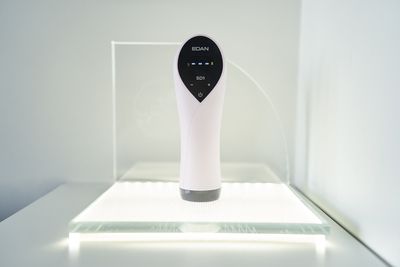Fetal Ultrasound Center opened online shop
Due to the coronavirus pandemic, and the emergency situation officially declared in Estonia, the pregnancy monitoring system has changed. Now some scheduled visits by midwives and gynecologists take place by phone.
In order for expectant mothers to know more about the well-being of the babies in their bellies, and provide more information to midwives, expectant mothers can perform home monitoring of fetal heartbeats in advance. They can then send pictures of them and, if necessary, their blood pressure values to their monitoring midwives.
Home monitoring of fetal heartbeats can be performed with a fetal doppler. In order to offer this fetal doppler to women, it was necessary to create an online store on the website of the Fetal Ultrasound Center. Thanks to the Best IT team, he is now ready for the birthday of the Fetal Ultrasound Center.
Edan SD-1 fetal doppler
This is a professional ultrasound device for home use that lets you listen to a fetus’ heartbeat and assess its well-being.
- All-in-one solution
- Built-in speaker
- Digital fetal heart rate monitor
- 3 MHz sensor detects fetal heartbeat
- Touch panel for easy handling
- Adjustable volume
- Indicates heart rate between 50 and 240 beats per minute
- Powered by AA 1.5 V batteries
- Bluetooth connection to a smart device
- An Android or iOS app to download to your smartphone to visually record fetal heart rate
- Automatic shut off saves batteries
- Pulse wave technology
- Weight 180 g
Standard equipment
Fetal doppler device, black device carrying case, 60 ml ultrasonic gel, screwdriver, 2 x AA batteries
Video guide
More informatsion
Fetal doppler EDAN SD-1 is a professional medical device that can also be used at home.
Although under ideal conditions, fetal heartbeat can be detected with a fetal doppler from 12 weeks of gestation, the best time to assess fetal heartbeat is from 20 weeks of gestation.
With a fetal doppler, it is possible to listen to the fetal heart rate and thereby assess the oxygen supply to the fetal central nervous system, which reflects the child's well-being. The heart rate of an unborn baby is 110-150 times per minute, and a normal heart rate indicates that the fetus is in good condition. Of course, a child's heart rate also depends on whether the child is calm or awake.
Fetal doppler is an ultrasonic sensor that emits and captures ultrasonic waves. The fetal doppler uses a frequency that is not harmful to either the fetus or the mother. Not even dolphins or bats can hear it.
The fetal doppler is a simple and easy-to-handle device. It can be turned on with the On/Off button and the volume can be changed as well.
The clearest sound can be obtained when listening to the child's heartbeat from behind. A child communicates with the mother with its feet and thanks her for the good food, so if the mother feels the child's movements more on her right side, the child's back is on the left side; if the mother feels the child's movements more on her left side, then the child's back is on the right side. When the child's head is down, the heartbeat is detected below the navel, when the child's head is up, the child's heartbeat is detected above the navel.
In order for the fetal doppler ultrasound waves to reach the fetus better, we need to cover the sensor with gel.
To hear the fetal heartbeat, we need to push the fetal doppler relatively hard against the abdominal wall. We hear fetal heartbeat as a double heartbeat, and they are usually faster than the mother's own heartbeat.
It is possible to connect the Edan doppler to your smart device via Bluetooth, which allows you to visually assess the change in the fetal heart rate over time and save it on the smart device and, if necessary, send it to your midwife or gynecologist to assess the well-being of the fetus.
The fetal doppler gives you the opportunity to assess the well-being of your unborn child in the safety of your own home.
You may benefit from a fetal doppler if:
- the fetus has recently moved less, or the normal rhythm of its movement has changed
- you have been diagnosed with fetal growth retardation of there is a suspicion of it (in between the doctor’s of midwife’s visits)
- your previous child died prenatally or had unexplained growth retardation
- you have been diagnosed with a lack or excess of amniotic fluid (in between the doctor’s or midwife’s visits)
- you have multiple pregnancy (diagnosed in between doctor’s of midwife’s visits)
- you have rhesus antibodies in your blood during pregnancy
- you have been diagnosed with pre-eclampsia, high blood pressure, diabetes, hepatogestosis during pregnancy (in between the doctor’s of midwife’s visits)
- you have been diagnosed with a serious illness (high blood pressure, diabetes, chronic kidney disease) before pregnancy
Risks of using a fetal doppler
Although the ultrasound waves employed in the fetal doppler are not dangerous to the fetus, there is the possibility that if the equipment is used inexpertly and a medical condition is ignored, a pregnant women may go to see her midwife or gynecologist too late when the situation of the fetus has already seriously deteriorated. Therefore, a fetal doppler examination should not be treated as a substitute for a visit to a midwife or gynecologist. If you have the slightest suspicion that your fetus is feeling unwell, be sure to contact your midwife or gynecologist.

